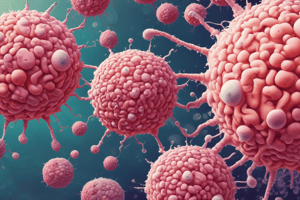Podcast
Questions and Answers
Which toxin of Staphylococcus aureus can cause necrotic lesions of the skin or mucous membranes, including necrotic haemorrhagic pneumonia?
Which toxin of Staphylococcus aureus can cause necrotic lesions of the skin or mucous membranes, including necrotic haemorrhagic pneumonia?
- Exfoliative toxins (correct)
- Panton-Valentine leukocidin
- Enterotoxin A
- Hemolysins
Which of the following toxins of Staphylococcus aureus is responsible for causing Staphylococcal Scalded Skin Syndrome (SSSS)?
Which of the following toxins of Staphylococcus aureus is responsible for causing Staphylococcal Scalded Skin Syndrome (SSSS)?
- Enterotoxin A (correct)
- Panton-Valentine leukocidin
- Exfoliative toxins
- Hemolysins
What is the most common food-borne enterobacterial infection?
What is the most common food-borne enterobacterial infection?
- Salmonellosis (correct)
- Typhoid fever
- Escherichiosis
- Dysentery
Which bacteria is characteristic of lactose fermentation?
Which bacteria is characteristic of lactose fermentation?
Where is the O-antigen of enterobacteria found?
Where is the O-antigen of enterobacteria found?
Which of the following is NOT one of the toxins causing food poisoning by Staphylococcus aureus?
Which of the following is NOT one of the toxins causing food poisoning by Staphylococcus aureus?
Which of the following bacteria is an obligate representative of normal human microflora?
Which of the following bacteria is an obligate representative of normal human microflora?
What type of respiration does enterobacteria typically exhibit?
What type of respiration does enterobacteria typically exhibit?
Which of the following pathogens is commonly associated with elevated urinary tract infections?
Which of the following pathogens is commonly associated with elevated urinary tract infections?
Which characteristic is common to all members of the Enterobacteriaceae family?
Which characteristic is common to all members of the Enterobacteriaceae family?
How do pathogenic Escherichias differentiate from opportunistic pathogens?
How do pathogenic Escherichias differentiate from opportunistic pathogens?
Shigella has the following main antigens:
Shigella has the following main antigens:
Which enterobacterium is an obligate representative of normal human microflora?
Which enterobacterium is an obligate representative of normal human microflora?
What type of respiration do enterobacteria typically exhibit?
What type of respiration do enterobacteria typically exhibit?
Which enterobacterium most commonly causes elevated urinary tract infections?
Which enterobacterium most commonly causes elevated urinary tract infections?
Which characteristic is common to all members of the Enterobacteriaceae family?
Which characteristic is common to all members of the Enterobacteriaceae family?
How do pathogenic Escherichias differentiate from opportunistic pathogens?
How do pathogenic Escherichias differentiate from opportunistic pathogens?
Which of the following toxins of Staphylococcus aureus is responsible for causing necrotic lesions of the skin or mucous membranes, including necrotic haemorrhagic pneumonia?
Which of the following toxins of Staphylococcus aureus is responsible for causing necrotic lesions of the skin or mucous membranes, including necrotic haemorrhagic pneumonia?
What is the most common food-borne enterobacterial infection?
What is the most common food-borne enterobacterial infection?
Which of the following bacteria is characteristic of lactose fermentation?
Which of the following bacteria is characteristic of lactose fermentation?
Where is O-antigen of enterobacteria found?
Where is O-antigen of enterobacteria found?
Which type of respiration do enterobacteria typically exhibit?
Which type of respiration do enterobacteria typically exhibit?




